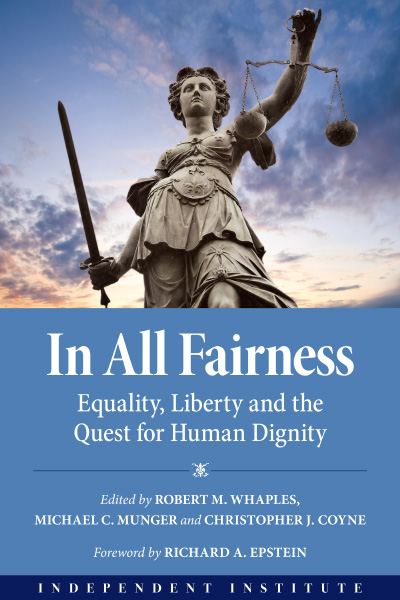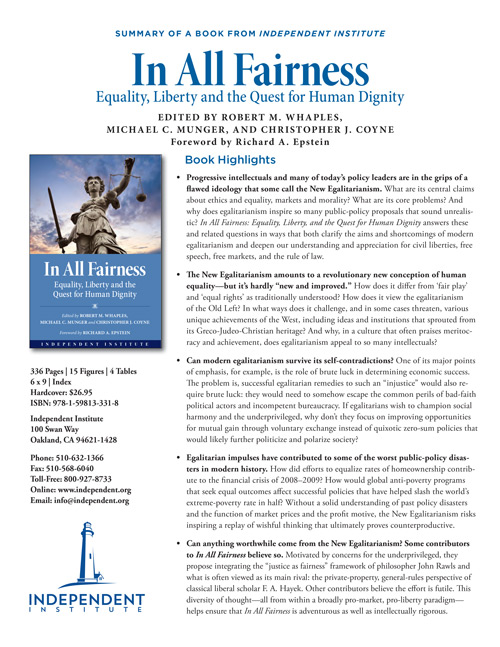Highlights
- Progressive intellectuals and many of today’s policy leaders are in the grips of a flawed ideology that some call the New Egalitarianism. What are its central claims about ethics and equality, markets and morality? What are its core problems? And why does egalitarianism inspire so many public-policy proposals that sound unrealistic? In All Fairness: Equality, Liberty, and the Quest for Human Dignity answers these and related questions in ways that both clarify the aims and shortcomings of modern egalitarianism and deepen our understanding and appreciation for civil liberties, free speech, free markets, and the rule of law.
- The New Egalitarianism amounts to a revolutionary new conception of human equality—but it’s hardly “new and improved.” How does it differ from ‘fair play’ and ‘equal rights’ as traditionally understood? How does it view the egalitarianism of the Old Left? In what ways does it challenge, and in some cases threaten, various unique achievements of the West, including ideas and institutions that sprouted from its Greco-Judeo-Christian heritage? And why, in a culture that often praises meritocracy and achievement, does egalitarianism appeal to so many intellectuals?
- Can modern egalitarianism survive its self-contradictions? One of its major points of emphasis, for example, is the role of brute luck in determining economic success. The problem is, successful egalitarian remedies to such an “injustice” would also require brute luck: they would need to somehow escape the common perils of bad-faith political actors and incompetent bureaucracy. If egalitarians wish to champion social harmony and the underprivileged, why don’t they focus on improving opportunities for mutual gain through voluntary exchange instead of quixotic zero-sum policies that would likely further politicize and polarize society?
- Egalitarian impulses have contributed to some of the worst public-policy disasters in modern history. How did efforts to equalize rates of homeownership contribute to the financial crisis of 2008–2009? How would global anti-poverty programs that seek equal outcomes affect successful policies that have helped slash the world’s extreme-poverty rate in half? Without a solid understanding of past policy disasters and the function of market prices and the profit motive, the New Egalitarianism risks inspiring a replay of wishful thinking that ultimately proves counterproductive.
- Can anything worthwhile come from the New Egalitarianism? Some contributors to In All Fairness believe so. Motivated by concerns for the underprivileged, they propose integrating the “justice as fairness” framework of philosopher John Rawls and what is often viewed as its main rival: the private-property, general-rules perspective of classical liberal scholar F. A. Hayek. Other contributors believe the effort is futile. This diversity of thought—all from within a broadly pro-market, pro-liberty paradigm—helps ensure that In All Fairness is adventurous as well as intellectually rigorous.
Synopsis
Recent hysteria about inequality has generated ill-conceived ideas about remaking American society. In All Fairness: Equality, Liberty, and the Quest for Human Dignity, edited by Robert M. Whaples, Michael C. Munger, and Christopher J. Coyne, brings together essays that challenge recent flawed egalitarian ideas, exposing the quicksand on which they rest and the self-serving interests they often promote. While each chapter offers unique insights, the overriding theme is that fairness must rest on a conception of humanity that recognizes the dignity of each person—a dignity that requires everyone to respect individual choices and voluntary transactions.
Rejecting top-down attempts to implement economic equality because they violate inviolable standards of justice and rarely achieve their putative ends, the book’s contributors call on authorities to remove policies that shackle individual initiative and favor those with political connections—and to rethink blunt redistribution because it transfers mere money, not the values and knowledge that allow us to flourish. Some of the essays carefully examine official statistics, concluding that they misleadingly exaggerate inequality.
In All Fairness knits together ideas from economics, philosophy, religion, law, and history—all firmly rooted in the classical liberal tradition. It will especially appeal to readers who are lost in the fog of a new egalitarianism that looks appealing but ultimately doesn’t make sense. Cutting through the haze and exposing the range of errors in the logic and practice of today’s egalitarians, it clears the path for a deeper understanding of equality, liberty, and the quest for human dignity.
Flaws of Modern Egalitarianism
Modern egalitarianism is a philosophy rife with problems running from its outer surface to its deepest core. After a foreword by Richard A. Epstein and introduction by Robert M. Whaples, Adam G. Martin kicks off the discussion by showing that today’s egalitarianism rejects older common-sense thinking. For example, whereas traditional concerns about racism emphasize individual conduct motivated by a dislike for other races and/or beliefs in their inferiority, the New Egalitarianism views racism far more broadly, equating it with “socially constructed, invisible systems conferring racial dominance.” And because unseen systems can be hard to identify, the New Egalitarians assert the need for a cadre of experts to identify the culpable elements and propose remedies. This approach, which has more than a hint of elitism, opens the door for sundry witch-hunts as the self-appointed authorities go about exorcising the demons of racial and social “privilege.”
“Brute luck” is another invisible force that the New Egalitarianism lament for causing social inequality. James R. Otteson questions this emphasis by showing—with a telling example of romantic bad luck—that misfortune often results from choices whose outcomes should be respected, not corrected. And because policies intended to advance egalitarian goals are far more difficult to craft than is generally acknowledged, their success would require a strong dose of brute luck.
Egalitarians, modern and traditional alike, usually take the fruits of market capitalism for granted. The danger, Michael C. Munger notes, is that egalitarian redistributionist policies could harm, if not kill, the goose that lays the golden egg: taking away profits from the capitalists diminishes the source of investment funds available to produce and market goods and services that benefit all consumers, including the poor.
Egalitarians fancy themselves as the vanguard of justice, but their approach is prone to injustice. Aeon Skoble suggests this is because they emphasize a derivative issue—equal distribution of wealth—and slight a morally fundamental issue—equal respect for negative (liberty) rights. Putting justice and liberty first, he argues, means prioritizing the ending of government actions that hinder economic opportunity; rethinking coercive redistribution that targets symptoms rather than causes of hardship; and repealing laws that target some groups disproportionately, such as incarceration arising from the war on drugs.
Short of a totalitarian regime, the objective of an equal distribution of wealth is utterly impossible, according to Jeremy Jackson and Jeffrey Palm. At root, this is because a key source of wealth in any economy is something that can’t be redistributed: social capital. This includes access to social networks, the soft-skills of social efficacy, and even positive outlooks imparted in a child’s home.
The Historical Development of Egalitarian Ideas
Modern egalitarianism clashes with the notion of human equality championed by classical liberals. Peter J. Hill explains how Western societies owe their commitment to human equality to the influence of Jewish and Christian ideas about human dignity and moral agency. Enlightenment-era thinkers also contributed by developing mores and laws that limited the use of power to enforce a particular definition of correct thinking.
Western ideas about equality have, over the past two hundred years, suffered conceptual deterioration, argues Jason Morgan. Egalitarianism has lowered the standards of good, better, and best and replaced them with the iron rule of absolute uniformity.
The corruption of the concept of human equality is evident in the arc of U.S. history, as James R. Harrigan and Ryan M. Yonk show. Belief in the rule of law and negative rights held sway for about one hundred years, after which the nation drifted to a system predicated on positive rights (i.e., entitlements to the fruits of others’ labors), resulting in redistributive policies that policymakers can propose rolling back only at their own electoral peril.
The historical effect of the egalitarian impulse can even be seen in the U.S. Supreme Court’s Fourteenth Amendment jurisprudence. After exploring the origins and evolution of due process and equal protection, William J. Watkins Jr. applies the wisdom and commonsense reasoning of legal scholar St. George Tucker and others to offer a jurisprudence congruent with F. A. Hayek’s understanding of equality under the law.
Egalitarianism, Economic Performance, and the Laws of Economics
Aside from its philosophical dilemmas, modern egalitarianism is an unsound basis for effective public policy. Stephen Shmanske gets to its core difficulties by way of contrast: he explains how only a free-market pricing system functions in a reasonable manner, encouraging people to be productive, avoiding the false promises and unfairness of the other systems.
The pursuit of equal outcomes also resulted in one of the worst policy disasters of recent history—the financial crisis of 2007 to 2009. Robert E. Wright demonstrates that the subprime mortgage collapse resulted largely from government policies that attempted to render equal that which was inherently unequal: creditworthiness.
Nor is global poverty alleviation a good candidate for coercive egalitarian policies. As Art Carden, Sarah Estelle and Anne Bradley explain, absolute poverty is declining around the world due to economic growth brought about by improved institutions and a new esteem for innovation.
Moreover, the cost of fighting inequality is often borne disproportionately by those it’s supposed to help—the poorest. Because of this tendency, Nikolai G. Wenzel argues that instead of equality of outcome, policy efforts should focus on equality of opportunity and economic freedom.
Egalitarians tend to err in their measurements of wealth inequality. As Ben O’Neill explains, this analysis fails by taking money as the measure of all things. When inequality is measured in appropriate “real” terms, with a fixed measuring rod, it becomes apparent that economic growth reduces inequalities of real wealth, even when the distribution of monetary wealth remains unequal.
Egalitarians also overestimate public support for their policy prescriptions. Brain J. Gaines examines public-opinion surveys to show that Americans favor rather flat and low taxes and embrace equal treatment through (mostly) proportional taxation much more than through the equalizing of incomes or wealth via highly progressive taxes.
Egalitarians generally fail to appreciate one of the notable facts of recent economic history: the spread of myriad technological conveniences across all income levels. While most households are gaining ground in absolute terms, Edward P. Stringham notes that egalitarianism criticizes this trend because some people are getting wealthy faster than others. Although any policy marketed as “We want to keep everyone more equal and poor” sounds absurd, Stringham shows that many current policies do just that.
Egalitarians also mismeasure inequality when they focus on differences in pretax income rather than consumption inequality. More fundamentally, Vincent Geloso and Steven G. Horwitz explain, egalitarians dismiss socially beneficial “good” inequalities that result from the satisfaction of individual economic preferences or demographic changes and have no perverse impact on economic growth. Their focus should switch to “bad” inequalities that stem from government policies that push down the left tail of the income distribution (such as zoning laws and the war on drugs) while pulling up the right tail (such as bank bailouts and barriers to entry into markets).
Michael C. Munger concludes the book by examining the relationship between the putative aims of modern egalitarianism and its coercive methods of enforcement, noting that it’s hard to imagine anything less egalitarian than rampant coercion exercised by an entity holding a monopoly on the use of force.








